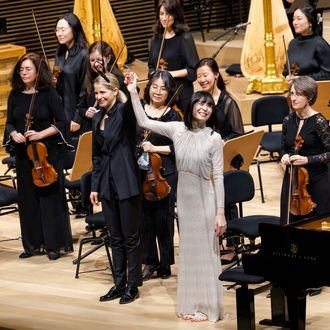
Some years ago, I spent a few months sitting in on a conducting seminar at Juilliard. It was a hyperelite form of pedagogy: an orchestra of 40 students doing the bidding of four trainee maestros, under the supervision of the New York PhilharmonicÔÇÖs music director at the time, Alan Gilbert. The standout in that tiny club was Karina Canellakis, a New Yorker who already had a couple of years playing violin in the Berlin Philharmonic under her belt and who impressed me with her precision and musicality and a work ethic that would have done John Henry proud. SheÔÇÖs now an established star in Europe (chief conductor of the Netherlands Radio Philharmonic and principal guest conductor of the London Philharmonic), but itÔÇÖs never too late to be a rookie. Her hometown debut with the New York Philharmonic was belated, then postponed, due to her pregnancy, and finally rattled by the aftermath of a minor earthquake.
During the concert, a chorus of piercing alerts set off hundreds of phones in Geffen Hall, helpfully informing the public that a tremor had taken place an hour before. Then came a series of after-alerts, scattered bleeps that kept ricocheting unstoppably from pocket to pocket for nearly two hours, inserting themselves into the spare textures of Webern, altering the ending of a Richard Strauss tone poem, and ripping through a quiet Satie piano solo. It was like going to a museum while a gang of activists rushes through the galleries aggressively hurling soup at all the paintings. Hardly a passage went untouched. (Either audience members really hate to turn their devices off, or they never learned how to kill their watches.) Kudos, then, to Canellakis, the pianist Alice Sara Ott, and the orchestra for soldiering through the din and turning out a concert that was by turns delicate, stirring, exciting, and joyous.
The program brimmed with elation in a range of disparate styles, from WebernÔÇÖs delight in brushstrokes of tone color to the great tolling, hollering finale of ScriabinÔÇÖs Poem of Ecstasy. WebernÔÇÖs ÔÇ£Six Pieces for Orchestra, Op. 6ÔÇØ skitter from quiet pinpricks to controlled explosions in a few brief and concentrated pages. Canellakis conducted it with a mixture of precision and fluidity, letting each droplet of sound have its moment of iridescence and, at the same time, channeling them all into a powerfully coherent stream. If only that final, lovely tintinnabulation of harp and celesta hadnÔÇÖt been riven by an electronic bleat.
The tone poem Death and Transfiguration chronicles a desperate deathbed struggle, but Strauss was only 25 when he finished it, and the score is shot through with optimism about the afterlife. That ringing, surging, elastic vigor fueled CanellakisÔÇÖs interpretation, packed with foreknowledge of the hurtling cataclysmic mode of Elektra and Salome, but also the more lilting, perfumed melancholy of Rosenkavalier. I would love to hear her conduct them all.
There was another major debut on the program, that of the pianist Alice Sara Ott, who romped through RavelÔÇÖs ÔÇ£G Major Piano ConcertoÔÇØ with obvious glee. ItÔÇÖs the kind of piece that encourages romping: fleet, cocky, colorful, and urbane, a FrenchmanÔÇÖs show-offy reworking of Gershwin. The buzz about Ott these days keeps coming back to her diagnosis of MS and her candor about it in public, but she showed herself no mercy, playing with needlelike lightness and wit.
Orchestras donÔÇÖt always seem to be having as good a time as they did in this concert. Offstage, the classical-music world is perpetually heavy with foreboding that this fragile art canÔÇÖt survive for long amid all the competition for attention and money. And yet, for a couple of hours in Geffen Hall, those anxieties seemed distant, blotted out by a sunniness that not even the emergency systemÔÇÖs automated hysteria could cloud. The last young conductor I reviewed, Klaus M├ñkel├ñ, was appointed to lead the Chicago Symphony Orchestra a couple of weeks later. Two more major American orchestras, the Los Angeles Philharmonic and the San Francisco Symphony, are still shopping for music directors. Canellakis, anyone?


